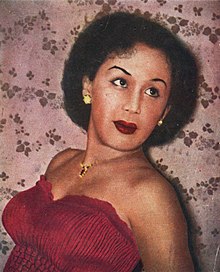Roostijati
Roostijati | |
|---|---|
 Roostijati in 1955 | |
| Born | December 27, 1925 Bandung, Dutch East Indies |
| Died | September 5, 1975 or September 11, 1975 (aged 49) |
| Nationality | Indonesian |
| Occupations |
|
| Years active | 1951–1955 |
Roostijati (Perfected Spelling: Roostiati; December 27, 1925 – September 5 or 11, 1975) was an Indonesian actress, soldier, radio announcer, director, athlete, teacher, and make-up artist. She was the sister of actor Djoni Sundawa and was the second Indonesian women director after Ratna Asmara by directing Genangan Air Mata (1955), and was one of the six Indonesian women director before 1998. She was the part of Classical Indonesian Cinema.
Born and raised in Bandung, Roostijati went to Hollandsch-Inlandsche School, and completed her education at Mode Vaak School. In 1945, she joined Laskar Wanita Indonesia (LASWI) as a captain, and moved to sector III, where she worked as a radio announcer and stole the power tools for soldier in forest.
Early life
Roostijati was born on December 27, 1925, in Bandung, West Java.[1] Her brother was actor Djoni Sundawa.[1]
She went to Hollandsch-Inlandsche School, and completed her education at Mode Vaak School.[1] During her school year, she was known for her sporting abilities and was referred as the star of show.[1]
Personal life
As of May 1955, Roostijati resided in Lembang, West Bandung, with her pet, a rooster and a dog. She died in Bandung, West Java, in September 1975, after suffered from illness for two years at the age of 49.[1][2]
Military career
From 1945 until 1947, Roostijati was a captain of Laskar Wanita Indonesia (LASWI) in North Bandung, under the lead of Yati Arudji.[1] She then joined sector III and started to working as a radio announcer, where she stole power tools for soldier in forest.[1]
Entertainment career
After the Indonesian National Revolution, Roostijati started her career as a regular radio announcer. She later became assistant treasurer of Persib Bandung, and won a ticket to visiting Produksi Film Negara (PFN) when Persib Bandung became a first runner up at the first National Sports Week.[1]
When visiting PFN, she was discovered by Dr. Huyung, who later gave her a supporting role in Kenangan Masa (1951).[1] After that, she was cast in several films, mostly in an action films such as: Gadis Olahraga (1951), Tenang Menanti (1952), Kumala Dewa Dewi (1952), Dewa Dewi (1952), Nachoda Harimau Lapar (1953), and Rosita (1953).[1]

In 1954, Roostijati starred as a leading role in Adios, the first Indonesian cowboy themed film.[1] She starred in two more films that year, such as: Konde Tjioda (1954), and Dewi Rimba (1954).[1] She starred in four films in 1955 such as Mustika Teratai Emas, Ada Gula Ada Semut, Habis Manis Sepah Dibuang, and her last film Genangan Air Mata, which she directed with The Teng Chun, and made her the second Indonesian women director after Ratna Asmara.[1] After leaving from the film industry, she worked as a make-up artist and teacher at beauty salon in Bandung.[1][2]
Screen persona and reception
Roostijati's screen persona focused on her ability to doing sports and fencing, she was nicknamed the first action film actress of Indonesia.[1] In her film, she often played the role of a tomboy woman who love to jumps, swings, riding horses, and sometimes showing her fencing skills.[1] Film Varia magazine often referred her as the manly female actress due to her habit of wearing boots to the film location, and for her performance in Kumala Dewa Dewi (1952).[3] Her fencing skill and technique often gained praise from the audience, and she was referred as the Maureen O'Hara of Indonesia.[4]
Filmography
Roostijati performed in a total of 32 films during her career, which many of them was considered lost.[2] Her directed film, Genangan Air Mata, remain banned by the censorship board.[2]
|
Legacy
Only six female directors appeared in Indonesian cinema until 1998; aside from Roostijati, these women directors were Ratna Asmara, Sofia W.D., Chitra Dewi, Ida Farida, and Rima Melati.[5] Of these, all except Farida had previous experience as actresses.[6] These directors rarely, if ever, received the same recognition as their male counterparts, and acting remained the only way for a woman in the industry to gain recognition.[7]
References
Works cited
- Biran, Misbach Yusa, ed. (1979). Apa Siapa Orang Film Indonesia 1926–1978 [What and Who: Film Figures in Indonesia, 1926–1978]. Sinematek Indonesia. OCLC 6655859.
- Apa Siapa Orang Film Indonesia [What and Who: Film Figures in Indonesia] (in Indonesian). Jakarta: Indonesian Ministry of Information. 1999. OCLC 44427179.
- Lent, John A (1999). Women and Mass Communications in 1990s: An International, Annotated Bibliography. Westport: Greenwood Press. ISBN 978-0-313-30209-1.
- Swestin, Grace (July 2012). "In the Boys' Club: A Historical Perspective on the Roles of Women in the Indonesian Cinema 1926 – May 1998". Scriptura. 3 (2). Surabaya: Petra Christian University: 103–111. doi:10.9744/scriptura.3.2.103-111.
- KNI (1975-09-23). "Peristiwa Budaya". Kompas (in Indonesian). p. 5. Retrieved 2023-04-08.
- Varia, Film (1954-05-06). "Surat-surat dari pembatja". Film Varia (in Indonesian). pp. 28–31.
External links
Roostijati at IMDb
